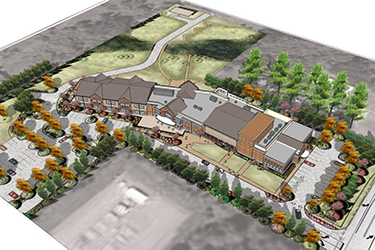|
Subscribe / Renew |
|
|
Contact Us |
|
| ► Subscribe to our Free Weekly Newsletter | |
| home | Welcome, sign in or click here to subscribe. | login |
Construction
| |
 |
April 24, 2014
Survey: Abbott Construction
Specialty: Healthcare, grocery, retail, hospitality, restaurants, industrial
Management: John McGowan, Doug Klein, Mark Seaman
Founded: 1983
Headquarters: Seattle (main office), Portland and Los Angeles (regional)
2013 revenues: $129.5 million
Projected 2014 revenues: $125 million
Current projects: CHC Edmonds; Ryther Child Center; Seattle Humane Society; Bear Creek Upper School; Metropolitan Market Tacoma; Alley 24 apartments; Swedish Pediatric Clinic West Seattle
Abbott Construction’s projects are all over the map, both in location and in type. The 31-year-old company focuses on everything from healthcare to retail and restaurants to apartments.
Doug Klein, vice president and regional director for Seattle and Portland, shared with the DJC details of some of the company’s biggest projects and his outlook on the industries Abbott covers. Answers have been edited for publication.
Q: You are working on the Semiahmoo project. What are some of the challenges?
A: As you can imagine, rebuilding a restaurant and bar housed in a turn-of-the-century (20th) fish cannery that is supported over a tidal zone by timber pilings comes with its share of challenges. We have been able to head off a majority of the challenges by conducting thorough building inspections to review existing structural, mechanical and electrical systems, as well as troubleshoot a myriad of existing issues with the exterior envelope and window systems.
GGLO presented design options that were respectful of the overall design intent and mindful of the critical systems necessary to operate a resort-class bar and restaurant service.
Q: What are healthcare and biotech clients looking for?
A: Northwest healthcare clients for the last five years have been looking for ways to have leaner operations, and have been focusing on the cost-effectiveness of outpatient facilities rather than building new hospitals. Prior to the downturn in the economy, large healthcare providers were looking to add more beds, but lately it seems the emphasis is on clinics with walk-in or urgent-care functions that can compete with traditional hospital emergency departments or ambulatory surgical centers.
Imaging and surgery suites will continue to get makeovers to accommodate the newest equipment and technology, but the shift seems to be toward cost—effective, quality healthcare provided at the point nearest the consumer. Additionally, with a focus on sustainability and cost-effectiveness of their central plants operation, more money is being put into infrastructure versus building structure, looking to make their operating dollar go further with a focus on sustainability.
We expect the growing population to force certain hospitals to continue to expand their bed count, but this time around it will be done less lavishly and with more focus on the efficiency of the building layout, systems and the way staff and patients use the building.
Q: You are doing some high-profile grocery stores. What are some trends in retail?
A: As a whole, we have seen the market leading the way toward a food revolution. Grocers are placing much more emphasis on organic products and locally sourced foods. Busy professionals are interested in shopping in an environment that promotes health and wellness. Grocers are supporting specialty prepared take-home foods and are undergoing face-lifts and product repositioning through remodels and re-branding of their stores. High-efficiency equipment and new refrigeration models are being implemented in a move toward LEED certification. Rounding out the move toward social and environmentally aware principles, the use of daylight harvesting combined with LED lighting provides a more natural environment in which to shop.
Q: How is your workload compared to previous years?
A: We are seeing more negotiated and short-list bid opportunities in the past six months than we did during the recent financial meltdown period, particularly in the healthcare, retail and nonprofit space, and more projects coming online in the $10 million to $20 million range. The Seattle market is still a very competitive construction arena. We are seeing an increase in smaller contractors competing on larger projects, larger contractors bidding on smaller projects, and more contractors competing from out of town. Abbott grew its revenue 30 percent last year, and we project to execute about the same for 2014.
Q: Which sectors are the strongest and which are stumbling?
A: The markets in which Abbott concentrates our business in have stayed relatively constant. Of course the housing boom in apartments, and to a certain extent condo development, has continued to push forward. As a result, we have seen a strong uptick in our grocery sector with new development opportunities and remodels. A number of our retail clients are expanding operations. The hospitality and restaurant sectors continue to expand with new opportunities and refreshes. Abbott’s specialty work in high-end construction of private residences, private hangars and private institutional buildings remains strong. We have seen a slight fall in our medical sector as operators are repositioning themselves in the wake of healthcare reform.
Other Stories:
- ABC Awards • Eagle of Excellence • Mixed-Use Construction
- Survey: Andersen Construction
- Survey: BNBuilders
- Survey: J.M. Riley Co.
- Financing equipment? Know these 7 things first
- Builder’s risk insurance can be a subcontractor’s best friend
- Worker shortage ‘coming at us like a freight train’
- New law protects contractor proposal information
- Reduce financial risk by tracking construction costs
- What can public agencies learn from Bertha’s journey?
- Survey: Skanska USA
- Survey: Mortenson Construction
- ABC Awards • Mechanical Construction
- ABC Awards • Demolition
- ABC Awards • Institutional
- ABC Awards • Community/Public Service
- ABC Awards • Commercial Construction
- ABC Awards • Electrical & Communications
- ABC Awards • Specialty Construction
- ABC Awards • Tenant Improvement
- Survey: Venture General Contracting
- Unique demolition project goes underground



